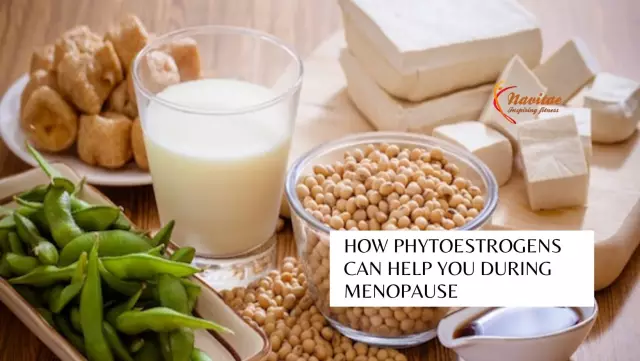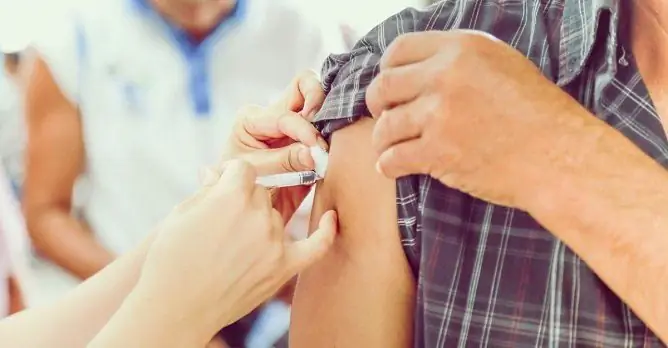- Author Rachel Wainwright [email protected].
- Public 2024-01-15 19:51.
- Last modified 2025-11-02 20:14.
Human papillomavirus vaccination
The content of the article:
- How vaccination works
-
Types of vaccinations
- Cervarix
- Gardasil
-
How is the vaccine done?
- How to prepare
- Procedure
- What to do after
- At what age should the vaccine be administered
- Side effects
- Contraindications to vaccination
-
HPV: what is it
- Features of papillomaviruses
- What diseases can HPV cause?
- Ways of transmission
- Doctor's advice
- Video
The human papillomavirus (HPV) vaccine is a specific prophylaxis method that prevents infection. Vaccination protects against one of the most common cancers, cervical cancer. Vaccination is indicated for girls before sexual activity. However, it can be carried out at an older age, but with much less efficiency. Vaccines do not contain live viruses, so by themselves they cannot cause infection and are not dangerous.

Human papillomavirus vaccine protects against certain types of cancer
How vaccination works
Vaccination against HPV is preventive, that is, it does not have medicinal properties. Vaccination is effective only in cases where the body has not previously encountered a certain type of HPV.
The vaccine contains purified L1 structural proteins. Probably, their introduction activates cellular immunity, but the exact mechanism of action of the vaccine is unknown. As a result, the immune system produces antibodies (protective proteins) against antigens (foreign particles of the virus), and the body becomes protected from 2-4 types of the most dangerous HPV.
Types of vaccinations
To date, there are two types of vaccines for human papillomavirus infection - Cervarix and Gardasil. Both are aimed at preventing the development of infection, not at treating it. The difference lies in the HPV genotypes that the vaccine protects against.
Cervarix
Cervarix is a bivalent vaccine that protects against HPV-16 and HPV-18. It is known that these types of papillomaviruses are responsible for the occurrence of approximately 75% of cases of cervical cancer. 0.5 ml of the drug contains 20 mg of HPV-16 and HPV-18 L1 protein.
Cervarix is used to prevent cervical cancer in girls from 10 to 25 years old. The vaccination course consists of the introduction of 3 doses of 0.5 ml. Because Cervarix only protects the body against HPV strains that cause cervical cancer, the vaccine is usually not given to males.

Cervarix vaccine protects against two oncogenic HPV strains
Gardasil
Gardasil is a quadrivalent vaccine that protects against HPV types 6, 11, 16 and 18. Each 0.5 ml of the vaccine contains 20 mg of HPV-6 and HPV-18 L1 protein, 40 mg of HPV-11 and HPV-16 L1 protein.
Gardasil not only protects against cervical cancer, but also prevents the appearance of anogenital warts and the development of vulvar and vaginal cancer in women. In some countries, Gardasil is used to prevent cancer of the penis and rectum in men.
The nine-valent Gardasil 9 vaccine protects against five additional types of papillomaviruses (types 31, 33, 45, 52 and 58).

Gardasil vaccine protects against four oncogenic HPV strains
How is the vaccine done?
The whole vaccination process can be divided into 3 parts - preparation, direct administration of the vaccine and observation.
How to prepare
No special preparation is required before vaccination. It is imperative to inform the doctor about the presence of the following conditions in the child:
- acute infectious disease, including the common cold;
- an unreasonable increase in body temperature;
- a history of allergic reactions to any vaccinations or drugs;
- food allergy;
- any somatic disease.
Procedure
Vaccination must be carried out in a special room - the vaccination room, which is equipped with everything necessary for the provision of medical care. The inoculation is done intramuscularly (in the deltoid muscle). The vaccination course consists of three injections, each time 0.5 ml of the drug is injected. The second injection is given after 2 months and the third after 6 months. The effect persists for 15 years, there is no data on the need for revaccination (repeated course of vaccinations).
What to do after
After vaccination, parents need to closely monitor the child's condition. If any symptoms appear, you should inform your doctor about their presence.
At what age should the vaccine be administered
Vaccination against HPV is indicated for girls from 10 to 25 years old. Moreover, the greatest effect of vaccination is expected when girls are vaccinated in early adolescence, before the onset of sexual activity.
Older girls already have a high risk of HPV infection after the onset of sexual activity, so the effectiveness of the vaccine decreases. However, the onset of sexual activity is not a contraindication to vaccination.
Side effects
In most cases, administration of the human papillomavirus vaccine is well tolerated and does not cause adverse reactions.
Approximately 10-20% of girls face the development of mild adverse reactions:
- swelling at the injection site;
- redness of the skin;
- painful sensations.
Such local reactions are physiological and do not pose a danger to the child's body, but it is still recommended to inform the doctor about the deterioration of health.
Systemic reactions are extremely rare (less than 1%) and can manifest themselves in the form of nausea, vomiting, headache, muscle weakness. When such a clinic appears, you should definitely consult a doctor. Allergic reactions can also develop, from skin rashes and itching to angioedema.
Contraindications to vaccination
The HPV vaccine is relatively safe, but there are some contraindications to its use.
When is it contraindicated to vaccinate:
- Severe allergic reaction to a previous dose of vaccine.
- Acute period of infectious diseases (can be vaccinated after recovery).
- Immunodeficiency states.
- Pregnancy.
- For a bivalent vaccine, the lactation period.
Fainting may develop in children and adolescents after the vaccine is given, so observation for 15 minutes after vaccination is recommended.
HPV: what is it
Human papillomavirus is the main causative agent of cervical cancer and other cancers. Knowledge of the structural features of viruses, ways of transmission of infection will help to better understand the nature of diseases.
Features of papillomaviruses
HPV (human papillomavirus) is a virus that causes papillomas and warts on the skin and mucous membranes, and is also the main cause of cervical cancer in women and some other cancers. Human papillomavirus infection is widespread - by the age of 50, about 80% of women are infected with at least one HPV strain. Today, there are more than 100 types (strains) of HPV, each of which can lead to the development of a particular pathology.
What diseases can HPV cause?
Cervical cancer is the main cancer that occurs as a result of human papillomavirus infection. Every year in the world there are 500 thousand new cases of the disease, about half of them are fatal.
However, cervical cancer is not the only disease caused by human papillomavirus infection.
| Pathology | HPV types that cause its development |
| Genital warts | HPV 6, 11, 42, 43, 44 and 54 types |
| Cancer of the cervix, vulva, vagina | In 70% of cases, the cause is HPV types 16 and 18, less often - 31, 33, 35, 39, 45, 51, 52, 54, 56, 66 and 68 |
| Laryngeal papilloma | 6, 11 and 30 types |
| Carcinoma of the neck, tongue | 2, 6, 11, 16, 18 and 30 types |
| Common warts | 2, 4, 26, 27, 29 and 57 types |
| Plantar warts | 1, 2 and 4 types |
| Flat warts | 3, 10, 28, 49 types |
Thus, papillomavirus can cause not only genital cancer in women and men, but also cancer of the tongue and neck. Also, papillomavirus infection can lead to the appearance of benign skin formations - papillomas and warts.
A feature of papillomaviruses is that they are capable of causing proliferation of the epithelium of the skin or mucous membranes. At the same time, different types of HPV have different degrees of oncogenicity. It is possible to determine the type of HPV, and, accordingly, its oncogenicity using polymerase chain reaction (PCR).
Ways of transmission
The main route of transmission of human papillomavirus infection is sexual. At the same time, the use of barrier methods of contraception (condoms) does not allow 100% to avoid infection. The fact is that even with the use of a condom, skin contact occurs in the genital area. Domestic infection is also possible (through touch, when visiting public places), but this rarely happens.
Doctor's advice
Today, vaccination is the most effective method of preventing human papillomavirus infection. The vaccine avoids the development of HPV infection and related cancers in 70-80% of cases. The effectiveness is much higher if girls are vaccinated before sexual activity and infection.
In addition to vaccination, there are non-specific prevention methods:
- use of barrier methods of contraception;
- compliance with the rules of intimate hygiene;
- frequent hand washing;
- using only personal hygiene items when visiting public places.
Nevertheless, even timely vaccination and adherence to non-specific prevention measures do not allow 100% to avoid cervical cancer. Therefore, it is imperative to visit a gynecologist and undergo preventive examinations. The main analysis that allows early diagnosis of cervical cancer is a cytological smear (Papanicolaou test, Pap test). The first Pap test is performed at the age of 21 or 3 years after the onset of sexual activity, then the smear is repeated annually.
Video
We offer for viewing a video on the topic of the article.

Anna Kozlova Medical journalist About the author
Education: Rostov State Medical University, specialty "General Medicine".
Found a mistake in the text? Select it and press Ctrl + Enter.






